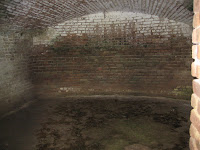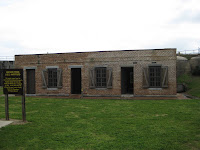



















































We left this morning for a short trip to Dauphin Island, AL to see Fort Gaines and to do some caching. The first stop was for a cache along a favorite fishing hole of the locals. The on to Alabama Port, AL and a cache located near an old cemetery. Then it was on to Dauphin along the 3 mile long causeway and bridge. We got there and did 3 caches one near the small airport, one close to the only golf course on the island and the last was in Little Billy Goat Hole Public Beach Access. Then it was on to see the fort across the street.
Fort Gaines was started in 1819 but never finished till 1861 due to many engineering problems. It was used during the Civil War and played an important part in the Battle of Mobile Bay, one of the war's most notable naval battles. In 1898 the fort was used again during the Spanish-American conflict during which time three 6" disappearing guns and three rapid fire3-inch guns were emplaced. The fort served in WW 1 with a Coastal Artillery unit garrison manning the disappearing guns. The site also became a anti-aircraft gunnery school during and following the war. WW 2 saw the fort used as a camp for the Alabama National Guard and a base for the U. S. Coast Guard stationed there to operate against the enemy subs prowling the gulf in search of merchant vessels. Presently the Coast Guard uses the fort as a base to take part in crash rescue boat operations. The U. S. sold the fort to the city of Mobile in 1926. The city in turn gave the property to the Alabama Dept. of Conservation, which deeded it to the Dauphin Island Park and Beach Board. If you have ever heard the saying "damn the torpedoes and full speed ahead" this was said by Admiral David Farragut during the Battle for Mobile Bay in 1864. A very interesting site to visit as you could almost picture the battle that raged there years ago.
After leaving the fort we found a cache located very near the fort itself in the woods, then it was on to the Audubon Bird Trail and a cache back in the woods about .3 of a mile, then it was the last cache on the island which was along a small nature walkway near the Coast Guard station. We left the island and headed back to Mobile and stopped for a cache near Bellingrath Gardens a place that of course has many very pictureque gardens and a mansion to go through. Then it was on to a cache located outside what we would call a REDNECK Bar if we ever saw one, the Bama Barn. No windows only one door and it had all kinds of trucks parked outside. Then it was on to a cache in a field, one along an old dirt road, one near a out of business store and then last cache was located near the County License office.
We drove back to the RV through the traffic which was just horrible. We have never seen such traffic, bumper to bumper, for miles. It took us 35 minutes to go 4 miles. The lights are excessively long and there are so many roads merging into the main road that it takes forever for them to change it seems. We got back and Mom put a load of wash in and I started the logs and she finished them and we both showered as it was fairly hot and muggy today. We are ordering from Pizza Hut tonight and going to watch tv. Well time to say until tomorrow and we love you all.
Picture List: 1-These letters are from an Indiana artilleryman whose unit was active in the fall of Fort Gaines, 2-A Lt. writes a mother of her son's death and the Civil Wars most famous love letter, 3-Martin Smith's final letters to loved ones were written while at Fort Gaines, 4-One of the oil rigs off the coast of Dauphin Island, 5&6-Pelican Pub & restaurant, 7-Fort Gaines, 8-Atop the fort looking out the firing positions, 9-Entrance to the fort, 10-The 2 cannons guarding the gate, 11-A 24 pound cannon overlooking the Bay, 12-A shell hit here from the USS Chickasaw during the Battle of Mobile Bay, 13-The disappearing gun mounts, 14,15,& 16-The Bakery-It was here that all the bread was cooked for the garrison. Storage of barrels of flour can be seen in #16. To use these ovens you would first build a fire in them and let it burn down to ashes. Ashes would be raked out of the ovens and the bread was placed in them by way of long bread boards. A set of iron doors were closed on the outside of the ovens and the radiant heat from the bricks baked the bread., 17,18,& 19-The Latrines-This was not your everyday outhouse. It was a 10 seater that connected by way of a culvert to the Bay. Once a day the tide would come in and out and flush the toilets. This was necessary being that over 400 men used these latrines daily. It was connected to the courtyard by a long tunnel and to the rifle lines by doorways to the left and right., 20,21&22-Blacksmith Shop-This area housed the garrison blacksmithing and forging operations, 23-The tracks on the ceiling by which travelled slings which hauled ammunition, 24&25-More pictures of the blacksmith and forging operations, 26-This is a piece of a ship wreck that washed ashore on Dauphin Island years ago. Due to the bolts and other hardware, we know it was built in the 20th century. Euorpean exploration began at least as early as 1513. By storms and wars (including subs in WW 2) ships have been lost in the waters for hundreds of years. 27-Ship's Rudder-This section of a ship's rudder was discovered by a shrimp boat 20 miles offshore. No other evidence of the ship wreck has been discovered. Expert analysis has determined: It was a sailing ship probably built between 1800 and 1850. Based on the size and shape of the rudder, the ship was more than 100' long. It was either a government vessel or owned by a rich individual or company. The copper sheathing was used to protect the structure from ship worms. This was a very expensive procedure at the time and therefore, rarely used., 28-Arensal Storage Room, 29&30-Anchor form the U. S. S Hartford-This abchor came from the U. S. S. Hartford, Admiral Farragut's flagship during the Civil War "Battle of Mobile Bay" in August of 1864. It was there that he uttered the now famous words "Damn the Torpedoes, Full Speed Ahead., 29,30&31-Officiers Quarters-This building was originally 3 stories tall but the upper floors were destroyed during the Battle for Mobile Bay. The standard garrison was 400 men and the enlisted men's barracks were outside the walls and were burned down during the battle as well., 32&35- Garrison Kitchen- From 1857-1900 this area served all the food for the garrisons needs. Notice the small ovens in the walls heated by coals from the fireplace. In the fireplaces large pieces of meat or stews could be cooked. The rooms to the right were used to store perishables. Cisterns, the ovals of stone to the left and right, held rain water to be used for drinking and cooking. 33&34-19th Century Shipwreck exposed by Hurricane Georges-The huge timbers you see are a ship's keel section washed ashore in the fury of Hurricane Georges in the fall of 1998. A house was destroyed by its impact. The remains formed the bottom ridge line of the ship and would have held the ribs of the ships hull. Analysis of the construction and materials indicate that the ship was built in the 1800's or earlier. The fate of the crew, its origin and purpose remain unknown. 36-50-These pictures show the bastions, tunnels, gun mounts, inside and outside walls, and various views of the inside of the fort.

No comments:
Post a Comment